The Travel Photo Trust Index: How Images Shape Travel Plans
Three in four Americans say they’ve been inspired to visit a destination based on a photo they saw on social media. But are some of those dreamy images doing more harm than good?
To find out, we surveyed 1,000 Americans on how travel photos impact trip planning, spending habits, and trust in what they see online. Results reveal a striking gap between expectations and reality, including how much people are willing to pay for a picture-perfect vacation.
Key Findings
- 83% feel anxious about AI (artificial intelligence) -altered travel photos (i.e., is what they’re seeing real?)
- More than 1 in 5 travelers booked a trip based on photos, then felt unsafe when they arrived
- Nearly 2 in 5 travelers have been let down by misleading travel photos; 10% even ended trips early because of it
- 1 in 4 choose vacation spots based on how attractive people look in destination photos, with 59% of Gen Z going this route
- Nearly 1 in 3 Gen Z travelers bring a plus-one just to take their photos and videos
- 42% say diverse representation in travel photos makes them more likely to visit a destination
How Often Are Travel Photos Misleading?
The pics promised paradise, but the reality? Not so much. 39% of Americans (two out of five) say they’ve been let down when the destination or accommodations didn’t live up to the dreamy visuals. And for many, it wasn’t just a letdown, it was enough to consider leaving. 32% thought about ending the trip early, 10% actually did.
Gen Z takes this even further. 53% say they’ve been misled, and 18% followed through by leaving the destination entirely. That’s nearly triple the rate of boomers, just 6% of whom took similar action.
The takeaway? Gen Z doesn’t suffer in silence… they just leave.
Pro tip for travel photographers: Misleading photos hurt your credibility. Prioritize authentic edits and honest descriptions to build trust with clients and audiences. Your reputation (and referrals) depend on it.
The Real-World Risks of Misleading Travel Images
Unrealistic photos don’t just disappoint; they can put travelers at risk. More than one in five (22%) booked a trip based on appealing images, only to arrive and feel unsafe.
Gen Z is especially vulnerable: two in five say their travel destination felt more dangerous than the photos suggested (nearly double the national average).
So what happens when travelers arrive in new cities or at their accommodations and feel blindsided by danger? Some cancel their plans and try to get a refund; others adapt on the fly.
Here are the most common things Americans say have looked very different from how they appeared online:
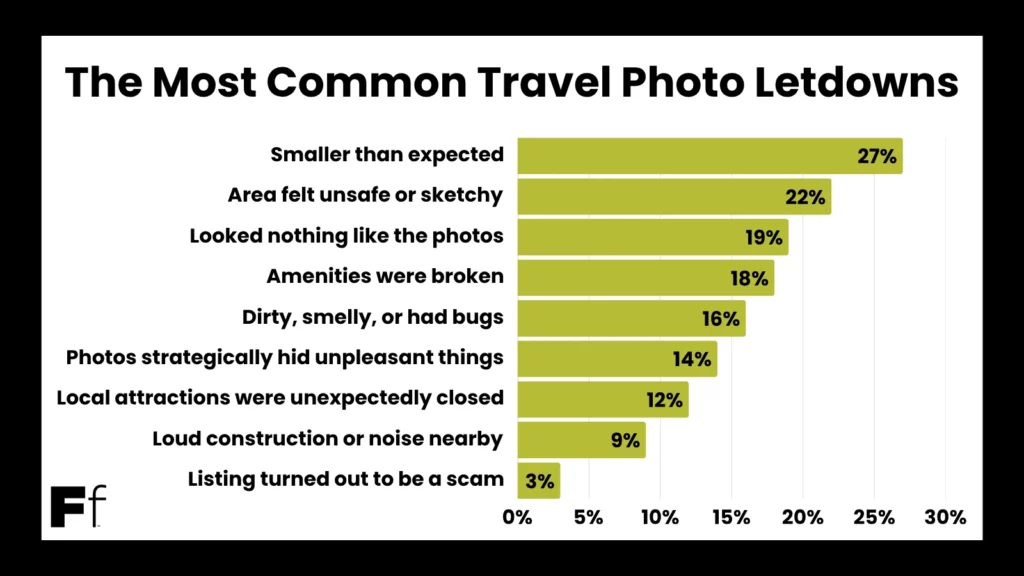
It’s not always a total bait-and-switch; sometimes the photos are just cleverly misleading. From outdated hotel listings to exaggerated lighting and filters, travelers say these are the most common ways photos distort reality before they arrive at an accommodation:
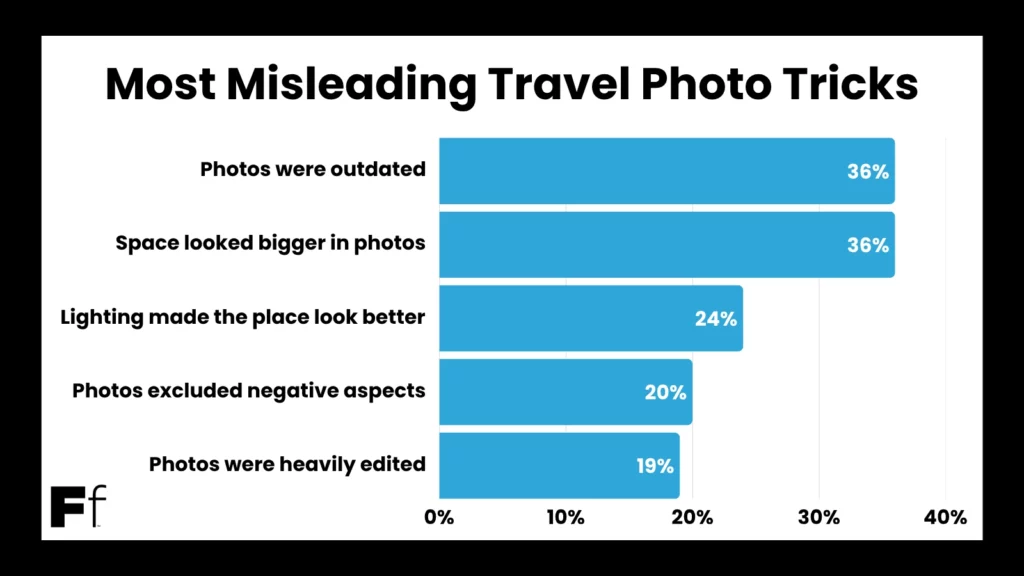
Pro tip for travel photographers: Avoid sharing photos that misrepresent a location. While they may attract attention, they can lead others to unsafe or disappointing experiences. Precision reflects professionalism.
“Gen Z is especially vulnerable: two in five say their travel destination felt more dangerous than the photos suggested (nearly double the national average).”
What Catches the Eye: How Photography Drives Travel Decisions
Nearly three in four (74%) admit that photos influence their travel decisions. Almost one in five, 17%, say pictures are the main reason they’ll book a trip to a specific city, region, or lodging.
What kind of travel photo makes someone stop scrolling and hit “book now”? We asked Americans which visual elements most influence their desire to visit a destination, especially when thinking about how it’ll look on social media.
Here’s what photo features are actually driving people to book.
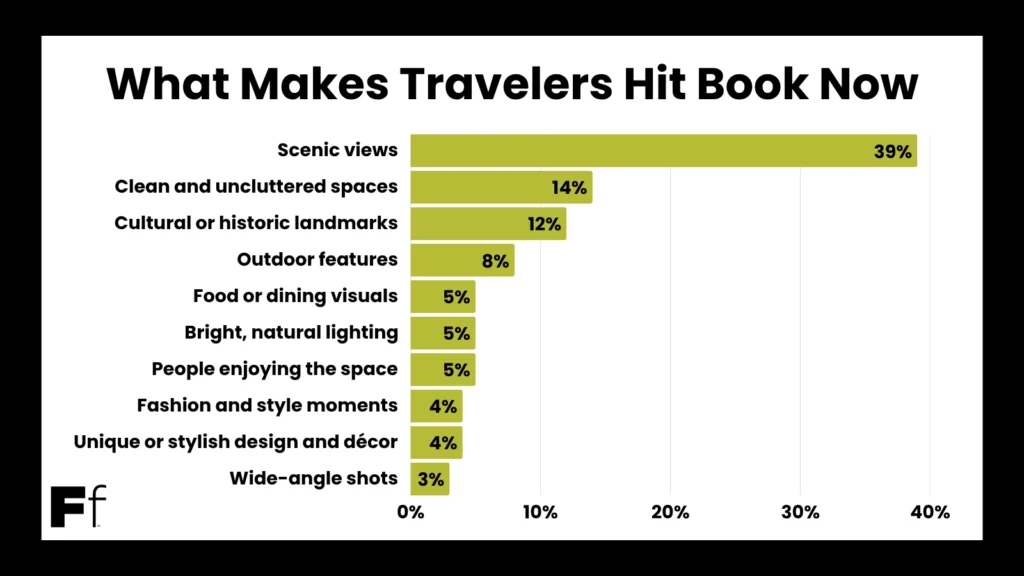
Pro tip for travel photographers: Scenery sells… but! Even if you’re out shooting on your own, accidents can happen. Make sure you have photography insurance in place so that an “oh no!” moment doesn’t ruin your adventure.
How Influencers Shape Travel Plans
Social media may dominate travel feeds and even plant the seed for future trips. Nearly two in five Americans (38%) added a destination to their bucket list based solely on a photo or video they saw online.
But inspiration doesn’t always lead to action. While one in four travelers (25%) say the latest social trends impact their booking decisions, even if they still do their own research, most aren’t swayed.
Over half (56%) make travel plans independently, and 14% actively avoid destinations that feel overly hyped on platforms like Instagram and TikTok.
Gen Z is the most influenced by social media. 60% say influencer content impacts where they travel, compared to 46% of millennials and 27% of Gen X. Influencer and celebrity travel posts spark mixed reactions
Pro tip for travel photographers: When partnering with an influencer, get on the same page about goals and visual style. To get the most out of your collab, plan for authentic, behind-the-scenes moments and encourage creative, eye-catching shots that reflect a unique point of view.
“Nearly two in five Americans (38%) added a destination to their bucket list based solely on a photo or video they saw online.”
The Demand for Travel Photography Is Growing
For some travelers, getting the perfect shot is the whole point. More than 10% of Americans brought someone along specifically to capture content, turning vacations into full-blown productions with curated photos, drone footage, and highlight reels.
And it’s not just about clout. For some, missing out on great photos would seriously dampen the experience. About one in 10 say not getting those key travel shots would feel like a letdown, and another third say photos are a nice bonus, even if they’re not a priority.
Gen Z leads the charge, nearly three in 10 (29%) travel with a content-creating companion. That’s nearly double the rate of millennials and almost 10 times more than baby boomers.
Pro tip for travel photographers: Turning your passion into your profession comes with challenges, even with demand rising for travel photography. If this sounds like where you are in your journey to become a photographer, check out our article on how to get more photography clients and build your brand.
Do Americans Trust Perfect Travel Photos?
A glossy feed with perfectly coiffed models and artfully arranged scenes might catch attention, but it also raises red flags. Over three-quarters of Americans are skeptical of destinations and accommodations that only post polished, curated content.
In fact, nearly two in three actively dig through user-generated photos to get a more honest look. This suggests that “too perfect” is now a trust issue, not a selling point.
Picture-perfect posts aren’t the biggest influence when it comes to booking… So what is?
Here’s what Americans trust most when choosing where to stay or visit.
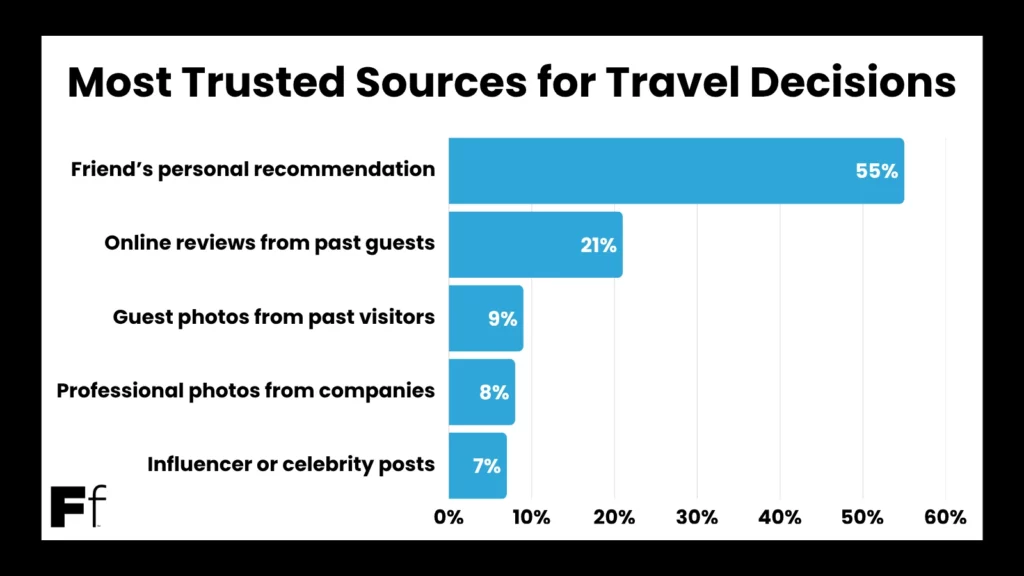
Pro tip for travel photographers: Avoid over-editing or striving for perfection in your photos, since images that feel too polished can come across as inauthentic. A more natural, editorial look helps build relatability and trust with your audience.
Where Travelers Turn for Honest, Reliable Travel Photos
So, where do travelers really look for photos before they book? Despite the hype around TikTok and Instagram, most Americans turn to more familiar and practical sources to guide their plans.
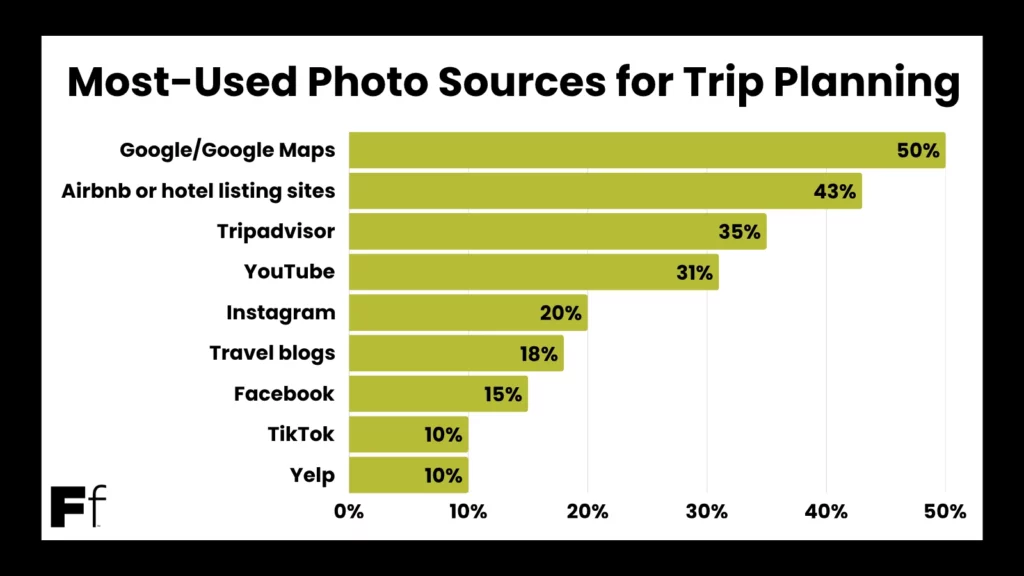
Unsurprisingly, Gen Z leans heavily on TikTok (38%) and Instagram (41%) for travel inspiration, more than any other generation. In contrast, just 2% of baby boomers use TikTok, and only 9% turn to Instagram.
But Gen Z isn’t relying on influencers alone: two-thirds also use Google Maps and Airbnb to plan trips. And 45% consult hotel websites, showing they value practicality as much as aesthetics when choosing places to stay.
With filters and curated content everywhere, can travelers really trust what they see online? We asked Americans which social media platforms show the most realistic travel content.
Here’s how they ranked the top five, from most to least trustworthy.
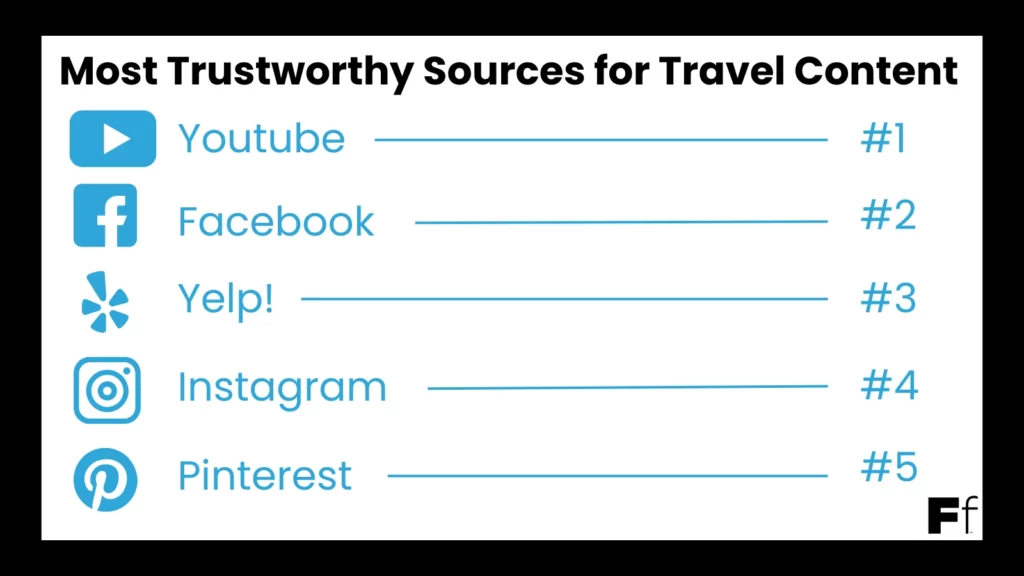
Pro tip for travel photographers: When posting travel photos, add accurate captions and contextual integrity (e.g., the location, subject names (if known), and any relevant cultural details).
“Over three-quarters of Americans are skeptical of destinations and accommodations that only post polished, curated content.”
Are Travelers Worried About AI-Generated Images?
AI is fueling growing mistrust in online travel content. 83% of Americans are anxious about AI-generated images making it harder to tell what’s real, and most think it’ll only get worse.
Only 6% believe AI will make travel photos more trustworthy in the future. But some travelers are leaning into AI tools. Not to generate content, but to help navigate it. Nearly three in 10 Americans (29%) say they’d use AI to help plan a trip, whether to spot fake photos or handle basic research, like finding places to stay.
But trust remains a major barrier: nearly a quarter (23%) say they wouldn’t trust AI with personal travel decisions, and one in three say they’d only use it if they could verify everything themselves.
Pro tip for travel photographers: Chances are you’re constantly uploading photos on the fly and trusting that they’ll be there, ready for you to deliver to your client. But you should be aware that cybercriminals won’t hesitate to ruin your ability to meet a contract’s deadline. Check out your online cyber liability risks and how to guard your portfolio and client deliverables online.
How Appearance in Photos Is Shaping Destination Choices
More than one in four Americans either traveled or are planning to travel somewhere just because the people in the photos looked attractive. For some, it’s not the beaches or landmarks that sell a trip—it’s the vibes.
For men, even more so than women: 35% of men say good-looking locals or visitors influenced where they go, vs. 21% of women. And Gen Z? A wild 59% say they’ve chosen (or plan to choose) a destination based on how “dateable” the people looked. Boomers? Just 7%.
Even income plays a role. Travelers earning under $50,000 are the most likely to let hot photos shape their itinerary.
Does Diversity in Travel Photos Matter to Travelers—and if So, How Much?
More than four in 10 (42%) Americans value diversity in travel photos, across race, body type, age, and ability. So much so that it makes them more likely to visit a destination.
For younger travelers, it’s especially impactful. 64% of Gen Z and 59% of millennials say inclusive imagery boosts a place’s appeal. Among baby boomers? Just 18% say it makes a difference.
Income matters here, too. Nearly half (48%) of Americans earning under $50,000 feel more drawn to destinations that show equal representation. This is only true for 37% of those making $150,000 or more.
Pro tip for travel photographers: Whether you’re photographing clients on location or snapping candid moments in a busy setting, there are inherent risks that come with the job. A little prep on your part can go a long way in helping you protect yourself and your business; see what kinds of photoshoot liability risks you need to guard against.
“And Gen Z? A wild 59% say they’ve chosen (or plan to choose) a destination based on how ‘dateable’ the people looked.”
How Much More Are Travelers Willing To Spend for a Picture-Perfect Destination?
Nearly 60% of Americans say they’d stretch their budget to stay somewhere that looks amazing in photos. For about one in five, that means spending more than 10% extra just to score the perfect backdrop. And 5% are willing to go all-in, tacking on 25% or more for the sake of aesthetics.
Still, not everyone’s buying into the photo-first mentality. Roughly two in five travelers say they won’t spend a penny more just for an accommodation that looks good online, and they don’t care about “Instagrammable” appeal at all.
Pro tip for travel photographers: High-quality destination photos do more than look good—they tell a story, build trust, and influence travel decisions. If you’re delivering that kind of value, don’t hesitate to price your work with confidence. Professional visuals deserve professional rates.
Are Travelers Willing To Sacrifice Style for Savings?
Some travelers are (literally) skipping the scenic route. More than a third of Americans (36%) said they picked less-attractive destinations specifically to save money.
But just as many (36%) refuse to compromise on aesthetics, no matter the cost. When it comes to travel, it’s beauty versus budget, and the country’s split.
Younger travelers are even more willing to trade aesthetics for savings. Over half of Gen Z (56%) booked less-than Instagrammable spots to save money, vs. 44% of millennials, 34% of Gen Xers, and just 23% of boomers. For Gen Z, it’s vibes or views, but not always both.
Are these more budget-friendly trips and accommodations satisfying? Depends on who you ask. About one in five travelers (21%) said choosing a less scenic spot paid off. But 15% admitted regret over going the cheaper route when the destination didn’t deliver.
Pro tip for photographers: Don’t underestimate low-budget clients or modest venues, they can still offer valuable experience, creative flexibility, and strong additions to your portfolio. Not every shoot will be glamorous, but every client relationship holds potential.
“Nearly 60% of Americans say they’d stretch their budget to stay somewhere that looks amazing in photos.”
The Real Costs of Misleading Photos
Misleading travel photos don’t just disappoint; they also cost people real money. Nearly half of travelers say they’ve lost cash on trips that didn’t live up to the pictures.
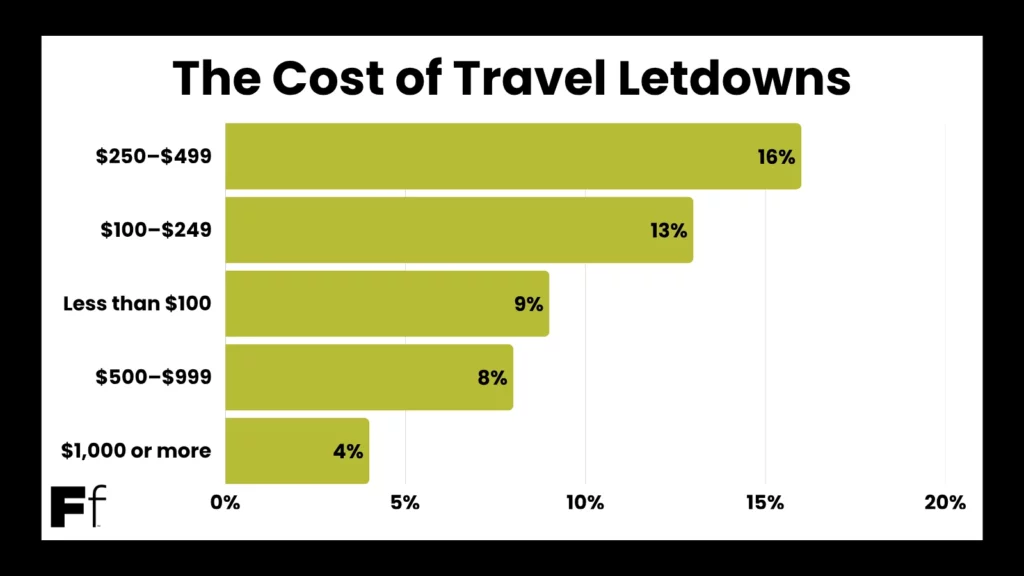
The more a generation relies on photos to plan trips, the more likely they are to lose money because of them. 72% of Gen Z, 62% of millennials, 52% of Gen X, and just 28% of baby boomers lost money when photos didn’t live up to their experiences.
As it turns out, travel photos can even cost you peace with your travel crew. About one in seven Americans (15%) say they’ve argued with a travel companion because the destination or accommodation didn’t live up to the pictures. For some, it sparked serious tension; for others, it was just enough to kill the vibe.
Not everyone handles travel letdowns the same way. Just 5% of boomers say a disappointing stay led to a fight, but tensions run higher with younger travelers. Nearly one in three Gen Zers (30%) and 22% of millennials say bad bookings have sparked real conflict.
Pro tip for travel photographers: Steer clear of misleading destination photos. What might seem to you like a small enhancement can result in real-world consequences for travelers, from letdowns to sunk costs. Authenticity safeguards your reputation, your audience, and your client.
What Travelers Really Value
When it comes to travel planning, honesty goes a long way. 82% of Americans say they appreciate realistic photos of a travel destination, even if that means showing construction zones, sketchy areas, or visible safety concerns.
Pro tip for travel photographers: Keep your photos honest; include real scenes, not just perfect moments. Avoid heavy editing or hiding crowds, signage, or weather when relevant to keep your work meaningful and relatable.
In a world of filters, influencers, and AI-generated perfection, Americans are becoming more cautious and skeptical about what they see online. Travel photos still inspire, but they can also mislead, cost money, and spark real regret. Whether it’s stretching budgets for the perfect shot or choosing less scenic stays to save cash, travelers are balancing aesthetics with authenticity. And one thing is clear: honesty in travel photos matters now more than ever.
Methodology
We surveyed 1,000 Americans via Pollfish across generations and income levels to understand how travel photos influence trip planning. To get a full picture, we asked about everything from influencer impact and AI-generated content to how often people choose or avoid destinations based on how they look online.
Fair Use Policy
Users are welcome to use the analyses and findings from this study for noncommercial purposes, such as academic research, educational presentations, and personal reference. However, when referencing or citing this article, please ensure proper attribution. Direct linking to this article is permissible and encouraged to provide readers with access to the primary source.
For commercial use or publication purposes—including but not limited to media outlets, websites, and promotional materials—please contact the authors for permission and licensing details. We appreciate your respect for intellectual property rights and adherence to ethical citation practices. Thank you for your interest in our research.
